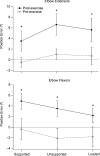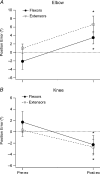The effect of fatigue from exercise on human limb position sense
- PMID: 20194123
- PMCID: PMC2872740
- DOI: 10.1113/jphysiol.2010.187732
The effect of fatigue from exercise on human limb position sense
Abstract
We have previously shown, in a two-limb position-matching task in human subjects, that exercise of elbow flexors of one arm led the forearm to be perceived as more extended, while exercise of knee extensors of one leg led the lower leg to be perceived as more flexed. These findings led us to propose that exercise disturbs position sense because subjects perceive their exercised muscles as longer than they actually are. In order to obtain further support for this hypothesis, in the first experiment reported here, elbow extensors were exercised, with the prediction that the exercised arm would be perceived as more flexed after exercise. The experiment was carried out under three load conditions, with the exercised arm resting on a support, with it supporting its own weight and with it supporting a load of 10% of its voluntary contraction strength. For each condition, the forearm was perceived as more extended, not more flexed, after exercise. This result was confirmed in a second experiment on elbow flexors. Again, under all three conditions the exercised arm was perceived as more extended. To explore the distribution of the phenomenon, in a third experiment finger flexor muscles were exercised. This had no significant effect on position sense at the elbow. In a fourth experiment, position sense at the knee was measured after knee flexors of one leg were exercised and, as for knee extensors, it led subjects to perceive their exercised leg to be more flexed at the knee than it actually was. Putting all the observations together, it is concluded that while the influences responsible for the effects of exercise may have a peripheral origin, their effect on position sense occurs centrally, perhaps at the level of the sensorimotor cortex.
Figures



Similar articles
-
Exercise, fatigue and proprioception: a retrospective.Exp Brain Res. 2019 Oct;237(10):2447-2459. doi: 10.1007/s00221-019-05634-8. Epub 2019 Aug 30. Exp Brain Res. 2019. PMID: 31471677 Review.
-
Human forearm position sense after fatigue of elbow flexor muscles.J Physiol. 2004 Jul 15;558(Pt 2):705-15. doi: 10.1113/jphysiol.2004.062703. Epub 2004 Jun 4. J Physiol. 2004. PMID: 15181165 Free PMC article.
-
A comparison of the effects of concentric versus eccentric exercise on force and position sense at the human elbow joint.Brain Res. 1997 Oct 17;771(2):251-8. doi: 10.1016/s0006-8993(97)00808-1. Brain Res. 1997. PMID: 9401745 Clinical Trial.
-
Effects of muscle conditioning on position sense at the human forearm during loading or fatigue of elbow flexors and the role of the sense of effort.J Physiol. 2007 Apr 15;580(Pt. 2):423-34. doi: 10.1113/jphysiol.2006.125161. Epub 2007 Jan 25. J Physiol. 2007. PMID: 17255167 Free PMC article.
-
What is the role of muscle receptors in proprioception?Muscle Nerve. 2005 Jun;31(6):780-7. doi: 10.1002/mus.20330. Muscle Nerve. 2005. PMID: 15818635 Review.
Cited by
-
Contributions of exercise-induced fatigue versus intertrial tendon vibration on visual-proprioceptive weighting for goal-directed movement.J Neurophysiol. 2020 Sep 1;124(3):802-814. doi: 10.1152/jn.00263.2020. Epub 2020 Aug 5. J Neurophysiol. 2020. PMID: 32755335 Free PMC article.
-
The effect of repetitive passive and active movements on proprioception ability in forearm supination.J Phys Ther Sci. 2013 May;25(5):587-90. doi: 10.1589/jpts.25.587. Epub 2013 Jun 29. J Phys Ther Sci. 2013. PMID: 24259808 Free PMC article.
-
The influence of age and surface compliance on changes in postural control and attention due to ankle neuromuscular fatigue.Exp Brain Res. 2014 Mar;232(3):837-45. doi: 10.1007/s00221-013-3795-7. Epub 2013 Dec 25. Exp Brain Res. 2014. PMID: 24368599 Free PMC article.
-
The fall in force after exercise disturbs position sense at the human forearm.Exp Brain Res. 2012 Oct;222(4):415-25. doi: 10.1007/s00221-012-3228-z. Epub 2012 Sep 1. Exp Brain Res. 2012. PMID: 22941313
-
Age-related deficit in a bimanual joint position matching task is amplitude dependent.Front Aging Neurosci. 2015 Aug 21;7:162. doi: 10.3389/fnagi.2015.00162. eCollection 2015. Front Aging Neurosci. 2015. PMID: 26347649 Free PMC article.
References
-
- Allen TJ, Proske U. Effect of muscle fatigue on the sense of limb position and movement. Exp Brain Res. 2006;170:30–38. - PubMed
-
- Brasil-Neto JP, Pascual-Leone A, Valls-Sole J, Cammarota A, Cohen LG, Hallett M. Postexercise depression of motor evoked potentials: a measure of central nervous system fatigue. Exp Brain Res. 1993;93:181–184. - PubMed
-
- Brockett C, Warren N, Gregory JE, Morgan DL, Proske U. A comparison of the effects of concentric versus eccentric exercise on force and position sense at the human elbow joint. Brain Res. 1997;771:251–258. - PubMed
MeSH terms
LinkOut - more resources
Full Text Sources
Other Literature Sources
Medical

